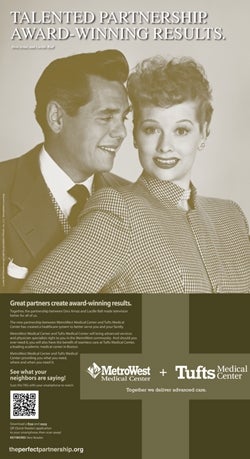Getting Smart About Smart Tags
When MetroWest Medical Center of Framingham began planning its media campaign to promote its new partnership with Tufts Medical Center of Boston, it of course considered print advertising.
But given that today is the age of social media, the marketing folks at both hospitals decided to try out some new technology to further engage consumers.
The new technology in this case was a QR code or smart tag. I wrote about these codes last year and decided to revisit them since they are slowly gaining more traction in the marketplace.
A QR Code looks like a scrambled up bar code. But instead of being scanned at a checkout counter, you can scan them using a reader on your smartphone. Once you launch the reader, just line up the camera on your phone with the QR Code, and viola! You’re instantly transported to someplace on the web — maybe a landing page to sign up for a coupon or an email newsletter.
Harness The Code
The power of this technology for marketers is endless. And for MetroWest Medical Center, it’s started to pay off, according to Stephanie Guidetti, vice president of marketing at the hospital.
The QR codes MetroWest Medical and Tufts used on print ads as well as posters, web banners and microsites, drove people to web videos that tied into the overall campaign’s theme of “great partnerships.” The videos feature people describing their favorite partnerships, like Lucy and Desi, peanut butter and jelly, and, of course, MetroWest Medical and Tufts.
Since rolling out the campaign in February, Guidetti says 1,000 people have scanned the tags. While that may not seem like a huge number, Guidetti is pleased with the results.
“I think that’s a successful measure of trying something new,” she said.
And Guidetti’s right. There’s still a pretty big knowledge gap around this technology. While QR codes are popping up everywhere, few people have stopped to figure out what to do with them. But as the penetration of smartphones continues to grow (it’s expected to increase by another 50 percent in the United States this year), consumers’ familiarity with the tags will move in concert.
But increasing QR code results isn’t just about educating consumers, according to Roger Matus, executive vice president at a tech company called Nellymoser out of Arlington.
Nellymoser entered the QR code space about a year-and-a-half ago and now helps clients integrate the technology into their marketing plans. For example, the company worked with Sports Illustrated on its 2011 swimsuit edition, which featured the codes linking to a plethora of online content, including interviews and innovative promotions.
While Matus acknowledges that QR codes are still relatively unknown, he says that will change quickly if marketers get creative with where they send people once they scan. Too often, he said, businesses use a code to send someone to a homepage. That is a mistake.
“Have you seen what those websites look like on mobile phones?” he asked. The answer, of course, is not good. And they also take forever to load. Give a person one bad experience with a QR code and you’re going to have a very hard time getting them to try it again.
That’s why Matus is a proponent of using the codes to link to videos. Clips hosted on YouTube are mobile ready, so your user is guaranteed to have a positive experience.
But if you don’t have the budget to work with an outside video producer, like MetroWest and Tufts did, you don’t have to give up. Video cameras are pretty cheap, and a quick clip of your CEO talking about your company’s mission might just do the trick. If not, Matus says marketers should focus on providing information. For a restaurant, that may be as simple as linking a QR Code to a list of the day’s specials.
The other key to making QR codes work, according to Matus, is placement and frequency. Make sure the QR code is obvious in your ad and use it over and over again in a million different places. Eventually, you’ll peak the consumer’s curiosity. It’s also important to give people instructions. Tell them what the code is, how to scan it and if they need to use a specific reader.
QR codes have a lot of potential, but it will take a lot of education for that potential to be realized.
Got news for our Digital Diva column? E-mail Christina H. Davis at cdavis@wbjournal.com.











0 Comments